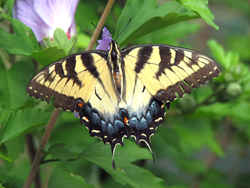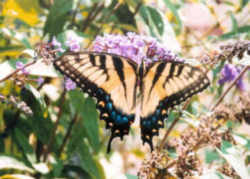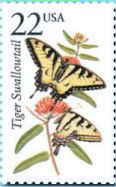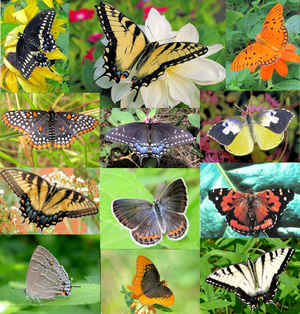
North Carolina Symbols
North Carolina State Butterfly
Eastern Tiger Swallowtail Butterfly

(Papilio glaucous)
Adopted on June 15, 2012.
The eastern tiger swallowtail butterfly become the newest North Carolina state symbol due to the efforts of the local Cape Fear Garden Club. The North Carolina General Assembly designated the Eastern tiger swallowtail (Papilio glaucus) as the official State butterfly of the State of North Carolina. The bill was ratified on June 11, 2012 and approved on June 15, 2012.
North Carolina Butterfly
Eastern Tiger Swallowtail Butterfly

The Eastern tiger swallowtail is native to North America and is generally considered the first North American butterfly to have been drawn. The first drawing of it was by John White. White was an artist, cartographer, and is also known as the governor of the Roanoke Island colony that came to be known as the "Lost Colony."
One of our largest, most beautiful, and fairly common butterflies, the Tiger Swallowtail in its light form is unmistakable. But the females in this area can be light or dark. The dark form females are thought to gain protection from predators by mimicking the Pipe Vine Swallowtail. Tiger Swallowtail larvae feed on a number of types of tree including Tulip Tree (Liriodendron tulipifera) and wild cherry (Prunus spp.).
Characteristics of the Eastern Tiger Swallowtail
The eastern tiger swallowtail, Papilio glaucus, one of the most common and widely distributed swallowtail butterflies in the eastern United States, has a wingspan that can reach 5 inches. The males' bright yellow wings have four black bands on the front wings, and a long black tail on each hind wing, and are easily identified. The first rendering of this species was of an adult male, drawn in 1587 by John White, commander of Sir Walter Raleigh's third expedition to North America. Some females, particularly those in the North, are black, with some blue interlaced with black bands on the hind wings. These females superficially resemble the poisonous blue pipevine swallowtail, Battus philenor.
Life Cycle
- Two flights generally occur in the north, and three or four flights take place as far south as Florida.
- Male swallowtails fly at treetop level and descend to mate with lower-flying females.
- Females lay single, globular greenish-yellow eggs on the surface of leaves, and the young larvae that result are dark and resemble bird droppings.
- The two-inch-long mature larva or caterpillar is bright green and swollen in front, with false black and orange eyespots. These larvae spin a silk "mat" on the leaf, which curls the edges of the leaf somewhat.
- Larvae feed until they are full-grown, then develop into a dark brown or greenish brown caterpillar and descend the trunk of the tree and pupate on the ground, creating a dark stick-like chrysalis in which they overwinter.
- The pupa is light brown with a dark brown or black lateral stripe and dark brown dorsal band.
Habitat
The tiger swallowtail is widely distributed from New England west through the southern Great Lakes area (along Merriam's "transition life zone") through most of the Great Plains states and south to Texas and Florida. In the transition zone, the eastern tiger swallowtail is sympatric with the closely related Canadian tiger swallowtail, Papilio canadensis (until recently, considered a subspecies of P. glaucus).
US Postal Service Wildlife Stamps

On June 13, 1987, the US Postal Service issued a sheet of 50 different stamps commemorating American wildlife. Many of the animals in the sheet are native to Georgia, but two - the Eastern Tiger Swallowtail Butterfly and the Bobwhite - are official state symbols of Georgia. On April 4, 1988, Gov. Joe Frank Harris signed an act of the General Assembly naming the Tiger Swallowtail as Georgia's official state butterfly to mark the opening of the Cecil B. Day Butterfly Center at Callaway Gardens in 1988.
Eastern Tiger Swallowtail Nominated to be named as a N.C. State Symbol
Details Published on Sunday, 17 June 2012 20:46 Island Gazette
Why nominate the Eastern Tiger Swallowtail Butterfly?
Approximately 175 species of butterflies are known to reside in North Carolina. Most of these breed in our state while some breed elsewhere and
migrate into the state. The Eastern Tiger Swallowtail is one of the most recognized and commonly seen species due to its size and beauty. With a wingspan
of 3 to 5.5 inches, bright yellow color with black tiger stripes, it commands our attention. In the central and western parts of the state the female
swallowtail can be dark with a bit of yellow with blue on her hind wings or yellow with black stripes and blue on the hind wings, while the male is
always yellow with black stripes and less blue on the hind wings. It should be noted that the Eastern Tiger Swallowtail is found in all 100 counties
of NC and is an easy butterfly to identify for the experienced butterflier, gardener, or a casual spectator, making it a natural selection to be the
North Carolina State Butterfly Symbol.
Where does the Eastern Tiger Swallowtail live?
The Eastern Tiger Swallowtail does not favor one county over another. Common habitats include along the edges of deciduous or mixed woods, fields,
rivers, creeks, roadsides, and gardens. They prefer open areas rather that shady areas. Because it has adapted to many different habitats and
host plants it is not considered threatened.
What does the Eastern Tiger Swallowtail eat?
Remember that butterflies must eat in two different stages of their life one being a caterpillar and another as a butterfly. As a caterpillar
they feed on specific plants including Tulip tree (Liriodendron tulipifera), Black Cherry (Prunus serotina), and Sweet bay (Magnolia virginiana). Nectar
plants for the adult butterfly are very widespread, but the species prefers tall herbs such as Joe-pye-weed (Eupatorium spp.), ironweed (Vernonia spp.)
and milkweed (Asclepias spp.). You will also find them sipping water and minerals from mud and possibly on dung and carrion.
When is the Eastern Tiger Swallowtail visible?
The butterfly flies from Spring to Fall producing two to three broods in a year. Males are often seen flying high in search of females while females
search out specific plants to lay their eggs. Their flight period ranges from early March to early October. In the Coastal Plain and Piedmont,
the butterflies can be seen from early March to late May, and early June to mid-September. Mountain flights generally occur from mid-March to mid-
or late June, and late June to early October. Adults are known to fly high above the ground, usually above the tree canopy.
Committee to Name the Eastern Tiger Swallowtail as a North Carolina State Symbol
Sponsored by Cape Fear Garden Club, Wilmington, NC
GENERAL ASSEMBLY OF NORTH CAROLINA
GENERAL ASSEMBLY OF NORTH CAROLINA
SESSION 2011
SESSION LAW 2012-29
SENATE BILL 236
AN ACT ADOPTING THE EASTERN TIGER SWALLOWTAIL AS THE OFFICIAL State BUTTERFLY, DESIGNATING THE SHELBY LIVERMUSH FESTIVAL AS THE OFFICIAL FALL LIVERMUSH
FESTIVAL OF THE STATE OF NORTH CAROLINA, DESIGNATING THE MARION LIVERMUSH FESTIVAL AS THE OFFICIAL SPRING LIVERMUSH FESTIVAL OF THE STATE OF NORTH
CAROLINA, and designating the swansboro mullet festival as the official mullet festival of north carolina.
The General Assembly of North Carolina enacts:
SECTION 1. Chapter 145 of the General Statutes is amended by adding the following sections:
"§ 145-38. State butterfly.
The Eastern tiger swallowtail (Papilio glaucus) is adopted as the official State butterfly of the State of North Carolina.
"§ 145-39. State spring and fall livermush festivals.
(a) The Shelby Livermush Festival is adopted as the official fall livermush festival of the State of North Carolina.
(b) The Marion Livermush Festival is adopted as the official spring livermush festival of the State of North Carolina.
"§ 145-40. State mullet festival.
The Swansboro Mullet Festival is adopted as the official mullet festival of the State of North Carolina."
SECTION 2. This act is effective when it becomes law.
In the General Assembly read three times and ratified this the 11th day of June, 2012.
s/ Walter H. Dalton
President of the Senate
s/ Dale R. Folwell
Speaker Pro Tempore of the House of Representatives
s/ Beverly E. Perdue
Governor
Approved 1:03 p.m. this 15th day of June, 2012
North Carolina Law
The law designating the Eastern tiger swallowtail as the official North Carolina state ibutterfly is found in the North Carolina General Statutes, Chapter 145 Section 145-38.
Chapter 145.
State Symbols and Other Official Adoptions.
§ 145-38. State butterfly.
The Eastern tiger swallowtail (Papilio glaucus) is adopted as the official State butterfly of the State of North Carolina. (2012-29, s. 1.)
Taxonomic Hierarchy: Eastern Tiger Swallowtail
Kingdom: Animalia (Animals)
Phylum: Arthropoda (Arthropods)
Subphylum: Hexapoda (Hexapods)
Class: Insecta (Insects)
Order: Lepidoptera (Butterflies and Moths)
Superfamily: Papilionoidea (Butterflies and Skippers)
Family: Papilionidae (Swallowtails, Parnassians)
Subfamily: Papilioninae
Tribe: Papilionini (Fluted Swallowtails)
Genus: Papilio
Species; glaucus (Eastern Tiger Swallowtail)
Butterflies, and Bugs







